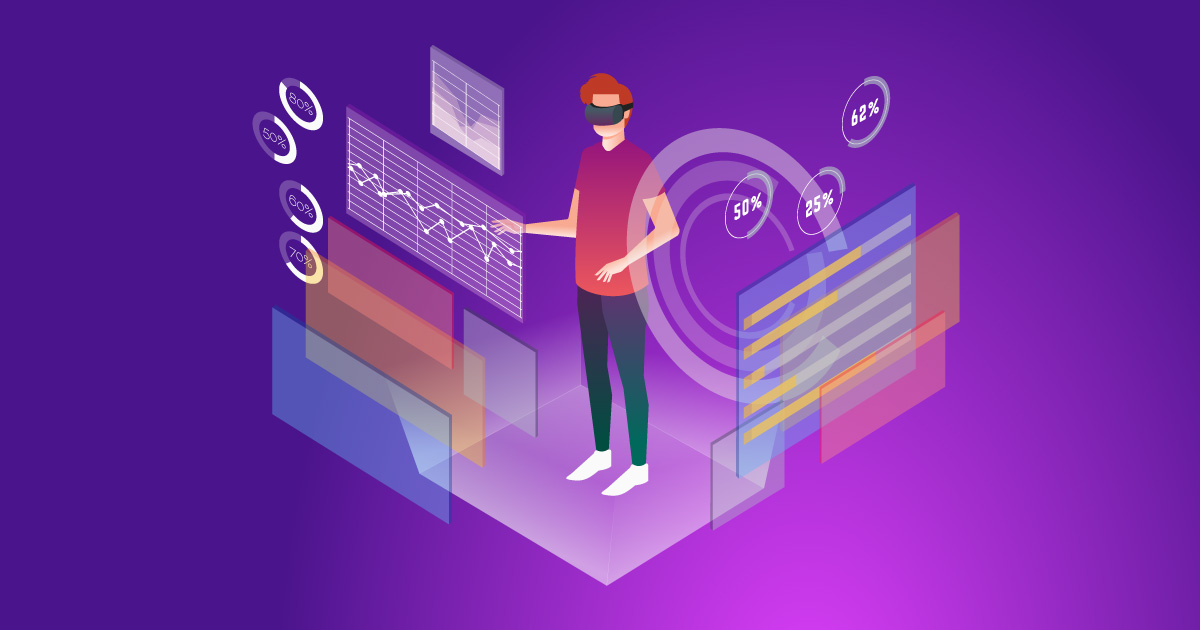How Augmented & Virtual Reality rule the business?

Data Scientist
Deep learning and machine learning specialist, well-versed with experience in Cloud infrastructure, Block-chain technologies, and Big Data solutions.
July 25, 2019
The two relative technologies, Augmented Reality and Virtual Reality are re-shaping every business sector giving new dimensions for the way we shop, play and work. You are performing surgery and if you could get an improved perception of inner organs, it will make the surgery more successful. Or as a housewife, you need to buy a new couch but is concerned about its appropriateness in your living room. Or as a military agent, you are involved in late-night combat and you need to have a better night sight to know what the enemy soldiers are aiming at. In one way or the other, every personnel or every industry calls for innovative technologies that assist them to visualize the real-world environment with high precision.

Marking its unavoidable presence in every business sector – healthcare, military, education, gaming, fashion, entertainment and much more, Augmented Reality (AR) & Virtual Reality (VR) is going to rule the year 2019. Experiencing a tremendous increase in the user base, the total number of VR users in 2018 was more than 150 billion. With a market value of 2 billion dollars in 2016, VR is growing more popular and successful compared to all other competing technologies. The market value of 26.8 billion dollars is going to get marked in the year 2022, according to Zion Market Research.
Worldwide, companies are getting the real picture about the limitless potential of these sibling technologies AR & VR and are investing their money and time in developing products & services based on Augmented Reality & Virtual Reality to take their businesses to the next level.
How Does Augmented Reality (AR) Work?
Augmented Reality is an interactive technology where the real-world objects in the physical environment are enhanced with computer-generated images. AR is not completely an artificial world but gives the real world view in an enhanced manner by including sound, graphics and video components.
The birth of AR stems back to 1990s and with the introduction of smartphones, the concept got a second life. Today, there are four types of Augmented Reality available. They are:
- Markerless AR
- Marker-Based AR
- Projection-Based AR
- Superimposition-Based AR
How Does Virtual Reality (VR) Work?
Virtual Reality is a computer technology that seamlessly creates a simulated environment. The most popular and common product of VR is a head-mounted display or simply, HMD. People may often get it confused with that of traditional interactive user interfaces. The main difference lies in its experience. Traditional user interfaces create a view in front of the user, whereas Virtual Reality takes its users into that virtual world and make them completely immersed in the world. You feel like interacting with the 3 D objects present in the environment in all the possible ways – through your vision, touch, hearing and even through smell.
So, here lies the difference: Augmented Reality Vs Virtual Reality
- Augmented Reality is a better view of the real world created by simply incorporating virtual information like videos, sounds and graphics into it.
- Unlike Augmented Reality, Virtual Reality creates a virtual world where you inhibit.
- Sensors and algorithm are used by computers to flawlessly determine the position of the camera in Augmented Reality. AR then projects a 3 D world environment from the viewpoint of this camera. The success of Augmented Reality depends on the devices ability to flawlessly overlay digital information on to the real-world environment.
- Whereas in Virtual Reality, sensors and math are used by computers to determine the position of the eye instead of locating the orientation of the camera as in Augmented Reality to render the virtual experience for VR users.
- The basic technological difference between AR and VR is – VR creates a completely new virtual world where the user feels that he lives in it, whereas AR superimposes virtual objects to create an enhanced real scene
An Ultimate Guide to AR and VR’s Impact on Business 2019
The sister technologies have an incredible power to blend the physical and virtual world to attract customers into your business. These technologies lay a new way of how customers interact with the business!
Augmented Reality: An In-Depth Analysis
Augmented reality is in its infancy stage and yet to flourish. But the stride it creates within the business world is enormous.
Slowly but steadily, the AR is going to change the face of every business. Augmented Reality finds diverse applications in various business sectors like Fashion & Retail, Real Estate, Interior Design, Tourism and Navigation, Military, Healthcare, etc.
Today, we will discuss more on the applications and benefits of Augmented Reality in the world of business.
- Fashion & Retail Industries
To make shopping fun and more accessible from any part of the world, Augmented Reality helps customers to have two real-world experiences - in-store experience and out-of-store experience, which takes your shopping to the next level. With in-store experience, customers will be given a virtual fitting room to decide upon the type, size and colour of the product you wish to have. Whereas, Out-of-store experience let your customers be in their homes and select their style choices from there.
- Real Estate Sector
More than 95 per cent of the people search online for buying properties and Augmented Reality is revolutionizing the sector with the type of visual interaction it offers the customers that make them visualize the 3 D view of the properties they plan to buy. From visualizing the pictures to the placement of the furniture in the new property, everything can be augmented for increasing the customer experience. What the customer should do is to take the pictures of your furniture set and add them in a listing. An AR-powered real estate app on your smartphone helps you to have a virtual tour of your properties even if you are miles apart. In a nutshell, Augmented Reality can save valuable time and money and prevent you from falling into the hands of fraud dealers.
- Interior design Industry
Like the real estate sector, the Interior design industry is also one of the beneficiaries of Augmented Reality. This technology enables potential customers to see how the products you intended to buy fits in your living spaces. In short, before making a purchase you can try products with free f cost.
- Tourism and Navigation
In the travel and tourism sector, AR fins numerous applications. Tourists who are keen on visiting museums will always get fascinated by the old century stuff. If a person what to know how a creature looks like in the original form by looking at the skeleton, it is where the Augmented Reality helps.
Moreover, countries like China leverage the potential of this technology to create travel-friendly and engaging shows and events that attract a very large number of tourists to their land. AR is not just limited to producing shows but is used to create interactive signs boards, road maps, visualize hotel rooms, which altogether make tourists feel that the country is the best tourist destination in the world.
- Education and Training
Introducing Augmented Reality into the classrooms is a revolutionary step and makes teaching a real fun. Subjects appealing to be difficult for students can be taught using different applications of AR so that they get in-depth knowledge on the subject. As an excellent teaching assistant, AR helps teachers in conveying the concepts of tough topics in a simpler manner.
- Healthcare sector
- When a technology acts beneficial for providing outstanding healthcare, it is the rise of humanity. With the support of Augmented Reality, the healthcare sector is preparing for a tremendous transformation. From assisting in carrying out a precise diagnosis to perform successful, yet complex surgeries, AR helps doctors and technicians in every task they do. Surgical visualization, vein visualization, deep view of internal organs, etc. are some of the applications of AR in the healthcare sector.
Virtual Reality: To Boost The Real Business Potential
- Data Visualization
From Pie charts and Line graphs, Data visualisation has scaled a long way. Visual platforms are being developed to make interactive presentations that aid businesses to have a clear understanding of the statistics. Innovative presentation platforms developed using VR technologies equips businesses to make productive business operations.
- Manufacturing Units
Designing and prototyping of various product models leveraging the power of Virtual Reality facilitate different manufacturing units to deliver best-in-class products into the market. For example, Airbus utilized the features of Realistic Anthropological Mathematical System (RAMSIS), a Virtual Reality technology to simulate the cabin’s interior design.
- Building and Construction sector
Freelance architects, builders and developers are the real beneficiaries when it comes to the integration of Virtual Reality into their businesses. Interactive Virtual Reality platforms enable architects to display 3 D models of the plans they have designed. This makes clients easier to understand the significance of your designs. In some cases, a partial narration and displaying of 2 D plans won’t make the business work out as you fail to convince the elegance of your designs.
The scope and applications of Augmented and Virtual Reality are not restricted within the above-mentioned business sectors. These sister technologies are growing beyond our imagination as an important part of our daily life.













